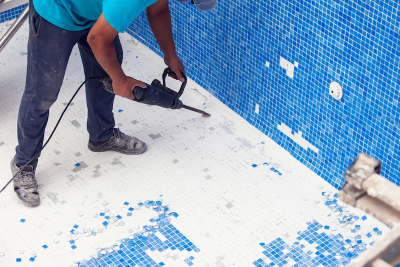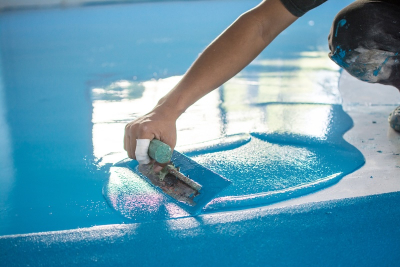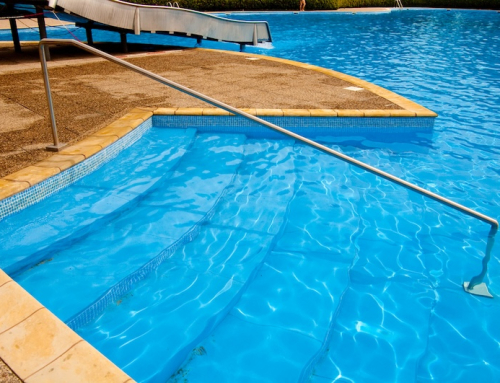If your pool looks dull, rough, or keeps fading no matter how much you clean, you’re not alone. Florida’s sun and humidity wear down finishes faster than anywhere else, leaving many homeowners stuck choosing between pool resurfacing vs pool painting. One promises quick results at a lower cost. The other takes longer but stands up to heat, water, and time.
You want a finish that lasts, not one that peels after a season. Knowing how each option holds up in Florida’s climate helps you spend wisely and avoid doing the same job twice.
Here, you’ll learn which finish protects your pool better, saves more in the long run, and keeps your backyard looking fresh year after year.
Understanding the Two Pool Finishing Methods
Before comparing how long each finish lasts, it helps to understand what goes into pool resurfacing vs pool painting. Both aim to refresh a worn swimming pool, but the materials, process, and results are completely different.
What Pool Resurfacing Involves

Resurfacing gives your pool a complete reset, not just a facelift. The process starts with draining the pool and removing the old, worn plaster so a new finish can properly bond. Once the surface is clean and prepped, contractors apply a fresh layer—often white plaster, quartz, or pebble—for a smooth, renewed look.
Some professionals mix in glass beads for richer color and better stain resistance. When done right, the new surface seals small cracks, reinforces the structure, and restores that cool, even texture underfoot. It takes skill and time to do correctly, but with balanced water chemistry and steady maintenance, a quality resurfacing job can easily last 10 to 15 years.
What Pool Painting Includes

Pool painting gives a fast refresh but doesn’t last as long as resurfacing. The pool is drained, cleaned, and acid-washed to prepare the surface. Contractors then roll or spray a thin coat of epoxy or acrylic paint to restore color and shine.
Epoxy holds up for about five years. Acrylic usually fades after two or three—sooner in Florida’s sun. Because paint sits on top of the surface, it peels and stains faster. To keep it looking clean, you’ll need regular touch-ups and more frequent maintenance.
Lifespan Comparison in Florida’s Climate
Now that you know the process, the next step is comparing how each finish performs under Florida’s tough conditions. High heat, constant UV, and year-round humidity make durability a key factor for pool owners.
How Heat, Humidity, and UV Affect Durability
Plaster holds up better against heat and chemical changes. Its thicker surface resists cracks and maintains a smooth feel, even in concrete or plaster pools exposed to direct sun. Paint, on the other hand, forms a much thinner coat. UV rays, pool chemicals, and debris wear it down quickly, causing peeling and fading. Over time, frequent maintenance becomes necessary to keep painted pools presentable.
Realistic Lifespans
Under proper water chemistry and maintenance:
-
- Pool resurfacing lasts 10–15 years, sometimes up to 20 with high-end materials.
-
- Pool painting lasts only 2–5 years before another paint job is due.
While painting may seem like a more cost-effective option initially, resurfacing offers the best long-term value and fewer interruptions for maintenance or repairs.
Cost and Maintenance Over Time
After learning what each finish involves, the next factor to weigh is cost and upkeep. The difference between pool resurfacing vs pool painting often comes down to paying more now or paying more later. Painting is cheaper upfront, but resurfacing offers better value over time.
Upfront vs Long-Term Costs
|
Feature |
Pool Painting (Epoxy/Acrylic) |
Pool Resurfacing (Plaster/Quartz/Pebble) |
|---|---|---|
|
Initial Price (per sq. ft.) |
$1 – $2 |
$4 – $10 |
|
Average Total Cost (1,000 sq. ft. pool) |
$1,000 – $2,000 |
$6,000 – $15,000+ |
|
Lifespan |
2 – 5 years (epoxy lasts longer than acrylic) |
10 – 20 years (plaster 7–10, quartz 10–15, pebble 15–20) |
|
Long-Term ROI |
Low – frequent repainting increases total cost |
High – longer lifespan reduces long-term expense |
|
Structural Protection |
Minimal – thin layer that can trap moisture |
Excellent – thick plaster layer seals cracks and protects shell |
Painting looks like the cheaper fix, but resurfacing wins over time. A full pool resurface lasts longer, handles Florida’s heat better, and protects the pool’s structure from water damage.
Maintenance Requirements
|
Requirement |
Pool Painting |
Pool Resurfacing |
|---|---|---|
|
Reapplication Frequency |
Every 2–5 years due to peeling or fading |
Every 10–20 years, depending on material |
|
Water Chemistry Sensitivity |
High – poor water chemistry causes blistering or chalking |
Moderate – proper maintenance prevents etching and stains |
|
Daily/Weekly Care |
Gentle brushing only; paint wears easily |
Regular brushing maintains smooth texture |
|
Common Issues |
Peeling, fading, blistering |
Etching, staining if neglected |
Painting demands more attention and frequent redo jobs, especially in Florida’s sun and humidity. Resurfacing costs more upfront, but its durability, lower maintenance, and long lifespan make it the better option for long-term savings and fewer headaches.
When to Choose Each Option
At this point, you know the main differences between pool resurfacing vs pool painting. The next step is deciding which fits your situation best. Your budget, pool’s condition, and long-term plans all play a role in making the right choice.
|
Situation |
Best Option |
Reason |
|---|---|---|
|
Small budget or rental property |
Pool Painting |
Quick, affordable fix to improve appearance short-term. |
|
Older pool needing full restoration |
Pool Resurfacing |
Repairs cracks, rough spots, and restores structural integrity. |
|
Preparing a home for sale |
Pool Painting |
Boosts curb appeal temporarily without major costs. |
|
Family home or long-term use |
Pool Resurfacing |
Offers 10–20 years of durability and higher resale value. |
|
Frequent chemical or salt exposure |
Pool Resurfacing |
Thicker plaster layer resists erosion and poor water chemistry. |
Painting can work as a stopgap, but resurfacing is the smarter move if you plan to stay in your home for years or want reliable protection.
Pool Resurfacing vs Pool Painting: Choosing the Right Finish for Lasting Results
Both options can restore a tired pool, but resurfacing lasts longer and stands up better to Florida’s heat and humidity. Painting costs less upfront, yet frequent touch-ups make it more expensive in the long run. Before deciding, look closely at your pool’s condition, budget, and how long you plan to stay in your home.
A smooth, durable finish protects the pool’s structure, improves safety, and keeps your property looking its best. For expert guidance and free estimates, contact Creative Resurfacing Solutions—Florida’s trusted professionals in pool resurfacing vs pool painting and long-term pool care.






